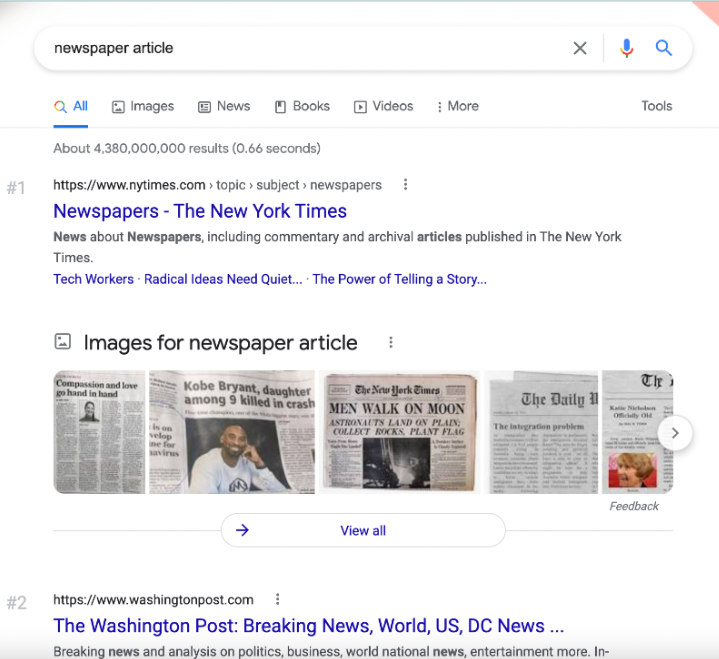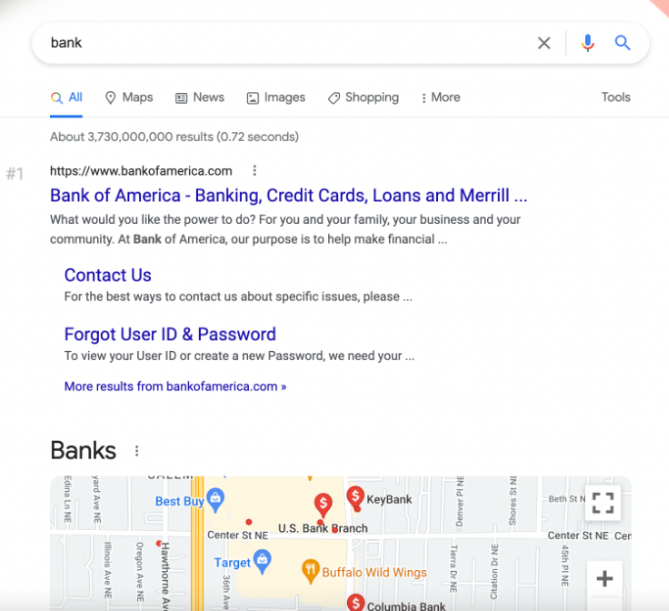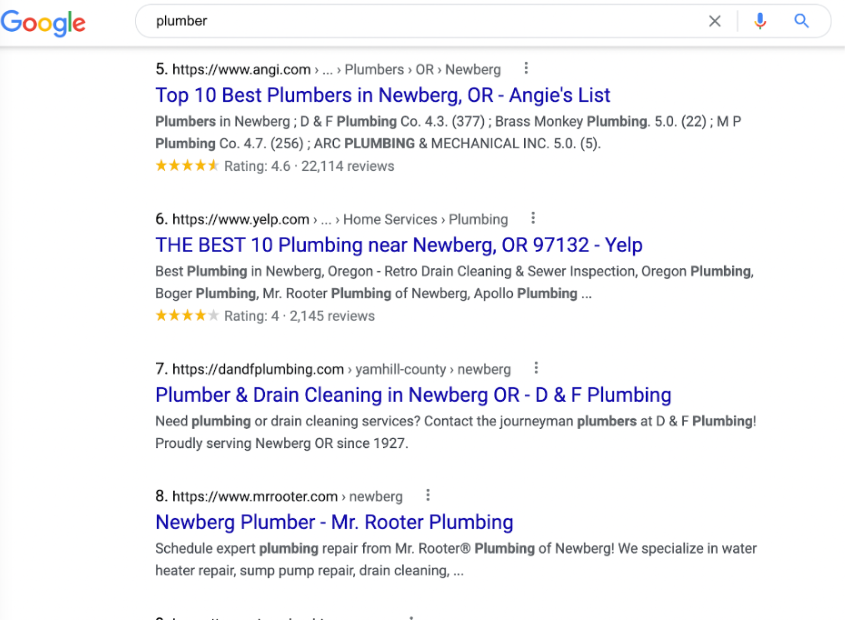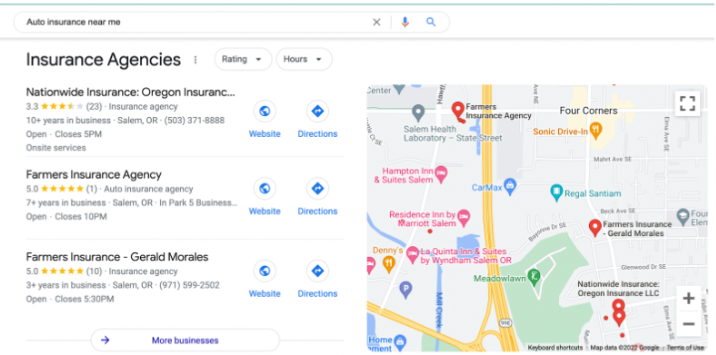Local SEO can be challenging for enterprise brands because it means knowing how to do “national” SEO, Google Business Profile, and then learning how Google handles your priority search queries in various markets.
That means there are an infinite number of challenges in local SEO for enterprise search marketers. So what are the most common challenges in enterprise local SEO? Let’s find out.
1. Knowing When To Prioritize Local vs. National SEO
One of the biggest challenges enterprises face is knowing when to focus on a “local” SEO strategy instead of a “national” SEO strategy and vice versa.
This is understandable as it’s not always immediately apparent if your priorities are better served by one or the other. It can be challenging to tell if your target top keywords have local intent.
But, it’s vital to success with your overall strategy because it will significantly impact how well your initiatives serve your business goals.
Understanding which terms Google regards as local can help you develop your keyword strategy and determine how to approach and support your SEO investment.
You could lose a lot of traffic due to poor site design or keyword strategy.
Understanding Local Search Intent
So, what do we mean by local search intent, exactly?
By understanding search intent, you know what kind of features will appear in search results and what content you should prioritize.
For this discussion, there are four main types of search intents to focus on:
- Search queries with national intent.
- Search queries with semi-national.
- Search queries with local intent.
- Search queries with hyper-local intent.
You can tell what type of intent your target search queries fall into by the features shown on the SERPs, for example:
Queries With National Search Intent
SERPs feature no state/city-specific pages and no map pack (example).

The fact that there are no “local’ results in this SERP probably means Google sees zero local intent for these queries.
The minute a large portion of searchers starts to redo this query with location info such as “Pleasanton newspaper article,” the SERPs will likely shift to results that have some local results, which brings us to…
Queries With Semi-National Search Intent
SERPs feature no state/city-specific pages but a map pack (example).
 Screenshot from search for [bank], Google, September 2022
Screenshot from search for [bank], Google, September 2022
Semi-national queries like [bank] might include a map pack because there’s an equal amount of local and national clicks. This could be because some users are looking for a bank branch close to them, but others are looking for the bank’s main home page.
Queries With Local Search Intent
SERPs feature partial to full state/city-specific pages and a map pack (example).
 Screenshot from search for [plumber], Google, September 2022
Screenshot from search for [plumber], Google, September 2022
For a term like [plumber], Google will feature a map pack of nearby plumbers, and the remainder of the page one results are filled with location pages. Google predicts that the user intends to find a plumber near their location.
Queries With Hyper-Local Search Intent
Hyper-local keywords are where the searcher’s location is the most significant and significantly impacts SERP results (example).
 Screenshot from search for [Auto insurance near me], Google, September 2022
Screenshot from search for [Auto insurance near me], Google, September 2022
In the case of hyper-local intent queries, the distance between the user and business matters most. You can see that the map pack dominates the SERP real estate for this query. So, Google likely thinks [Auto insurance near me] requires hyper-local results to be helpful for the user.
How To Identify Search Intent
- Analyze current SERP outcomes across different geos.
- Examine the SERP for a map element.
- Check for state or city-specific pages.
- Review the titles and URLs.
- Analyze consistency and make an intent determination.
How To Build A Strategy For Different Types Of Search Intent
National Strategy
Nationally focused strategies will need a ton of content and authority.
Your main website should be where you invest the most of your SEO budget if you’ve determined that your target keywords are in queries with little to no local intent. This will help you get that ranking by generating backlinks.
Semi-Local Strategy
Semi-local keywords will require the bulk of focus to build the content and authority of your main site with one additional point of focus. Because semi-local keywords generate a map pack, you must optimize your Google Business Profile listings.
Local Strategy
Your site structure will become significantly more important if you’ve determined that Google treats your keyword as local. You can increase the volume of searches if you create a directory of state or city pages.
Hyper-Local Strategy
When your priority keywords are hyper-local, creating a directory of state and city-level pages is preferable and optimizing them for near-me keywords with special location pages is preferable.
The layers will likely look different depending on your vertical, but broadly, they might resemble this:
- Locator index page.
- State page.
- City page.
- Location page.
2. Having A Single Source Of Truth For Location Data
With the advent of local listings management companies such as Yext and Uberall, this is no longer a problem.
However, we still run into multi-location businesses that don’t have a “single source of truth” for all of their location information.
If you don’t have this yet, put it in place.
3. Optimizing Store Locators
Many brands outsource their store locators to third-party vendors. There’s nothing wrong with this in theory, but there are a few ways we have seen this go wrong:
Search-Only Store Locators
For SEO, an effective store locator should be a basic linked set of state, city, and location pages that a bot or user can easily click around to get to every page. But many brands often build their store locators a locator page with a search box to find your location.
A few years ago, we looked at the locators for the top 100 U.S. retailers and found those with search-only locators ranked for ~50% fewer keywords than those with a linkable state > city > location architecture.
So, make sure your locator architecture is built this way.
Location Page Content
Often, brands budget for building a locator on their site but leave nothing for the content.
There’s nothing wrong with a basic location page with the business name, address, phone number, product/service categories, etc. But a location page with unique, beefed-up content relevant to the location and topics you are trying to rank for can improve SEO performance.
This is where your location managers can come in handy. We often see successful brands use surveys of their location managers to get unique local content.
Other sources might include local customer reviews, syndicated local point of interest data, and popular products in the specific market.
Priority Categories
Most ecommerce queries show local results near the top of the SERPs these days.
We often see brands winning in Local Packs linking from their location pages to their key categories.
Think of it as signaling to Google that your locations are relevant for these categories.
4. Google Business Profile Management And Optimization
Google Business Profile (GBP) really shouldn’t be a challenge – I mean, it’s just a simple set of yellow pages listings for your locations – but there are a million ways it can go wrong for businesses.
Here are just a few challenges and opportunities with GBP.
Beware Of Duplicate Listings
Amazingly, duplicate listings are still a thing with GBP, but I just talked to a service area business that was having problems ranking. It was pretty easy to see they had duplicate GBP listings.
The minute they deleted the duplicate listings, their rankings went up by 15 positions for the main keyword they were targeting. So, keep an eye on those.
Monitor Your GBP listings
Your GBP listings are in a constant state of flux. Users are adding photos and reviews.
Google can overwrite your data if it trusts data from another party more than it trusts you.
GBP is not a “set it and forget it” thing. Create a system to monitor changes to your GBP pages regularly.
While you can see many changes via the GBP Dashboard, it won’t catch everything. That’s one of the reasons we built this free, open-source tool to monitor image changes to your GBP.
Scale GBP Posts
GBP Posts are short announcements you can attach to your GBP. These can be an inexpensive way to generate high-converting visits to your site. Posts can include text, photos, or videos.
The challenge we often see is that businesses are often not set up to produce content for each location. If you want to do GBP Posts for multiple locations, implement a system for creating GBP-ready marketing collateral for new promotions so they can be posted.
This often involves creating a GBP-sized version (400 x 300) of approved marketing images and copy for GBP as part of each new promotion.
You’ll also want to ensure you tag links from your GBP posts with tracking parameters to measure performance.
5. Building A Local Search Presence For SABs And Marketplaces
Not every local enterprise brand has locations.
There are plenty of local marketplace brands like Yelp, DoorDash, and Zillow, and service area businesses (SABs) like plumbers and roofers that target local search queries but are not eligible to appear in Local Packs. This is because they have no physical locations in their target markets.
And this means they are missing out on many potential clicks and revenue.
This won’t work for every brand, but for those with a suitable business model, creating a “store within a store” at a partner brand’s location is a great way to get additional local pack visibility.
FedEx OnSite services located in Walgreens is a good example of how this can work:
 Screenshot from Google search, September 2022
Screenshot from Google search, September 2022
And, of course, if the value of the leads is high enough, you may want to consider opening up physical locations in certain areas to try to rank well in the Local Packs.
As I said at the top, there are an infinite number of local SEO tactics enterprise brands can deploy.
As you deploy new tactics, make sure you test, measure, and iterate like any other marketing channel.
More Resources:
Featured Image: GaudiLab/Shutterstock
window.addEventListener( ‘load’, function() {
setTimeout(function(){ striggerEvent( ‘load2’ ); }, 2000);
});
window.addEventListener( ‘load2’, function() {
if( sopp != ‘yes’ && addtl_consent != ‘1~’ && !ss_u ){
!function(f,b,e,v,n,t,s)
{if(f.fbq)return;n=f.fbq=function(){n.callMethod?
n.callMethod.apply(n,arguments):n.queue.push(arguments)};
if(!f._fbq)f._fbq=n;n.push=n;n.loaded=!0;n.version=’2.0′;
n.queue=[];t=b.createElement(e);t.async=!0;
t.src=v;s=b.getElementsByTagName(e)[0];
s.parentNode.insertBefore(t,s)}(window,document,’script’,
‘https://connect.facebook.net/en_US/fbevents.js’);
if( typeof sopp !== “undefined” && sopp === ‘yes’ ){
fbq(‘dataProcessingOptions’, [‘LDU’], 1, 1000);
}else{
fbq(‘dataProcessingOptions’, []);
}
fbq(‘init’, ‘1321385257908563’);
fbq(‘track’, ‘PageView’);
fbq(‘trackSingle’, ‘1321385257908563’, ‘ViewContent’, {
content_name: ‘enterprise-local-seo-challenges’,
content_category: ‘enterprise local-search’
});
}
});
Source
[sibwp_form id=1]


